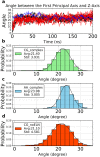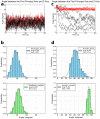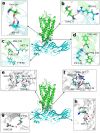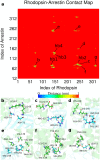The orientation and stability of the GPCR-Arrestin complex in a lipid bilayer
- PMID: 29209002
- PMCID: PMC5716996
- DOI: 10.1038/s41598-017-17243-y
The orientation and stability of the GPCR-Arrestin complex in a lipid bilayer
Abstract
G protein-coupled receptors (GPCRs) constitute a large family of membrane proteins that plays a key role in transmembrane signal transduction and draw wide attention since it was discovered. Arrestin is a small family of proteins which can bind to GPCRs, block G protein interactions and redirect signaling to G-protein-independent pathways. The detailed mechanism of how arrestin interacts with GPCR remains elusive. Here, we conducted molecular dynamics simulations with coarse-grained (CG) and all-atom (AA) models to study the complex structure formed by arrestin and rhodopsin, a prototypical GPCR, in a POPC bilayer. Our results indicate that the formation of the complex has a significant impact on arrestin which is tightly anchored onto the bilayer surface, while has a minor effect on the orientation of rhodopsin in the lipid bilayer. The formation of the complex induces an internal change of conformation and flexibility in both rhodopsin and arrestin, mainly at the binding interface. Further investigation on the interaction interface identified the hydrogen bond network, especially the long-lived hydrogen bonds, and the key residues at the contact interface, which are responsible for stabilizing the complex. These results help us to better understand how rhodopsin interacts with arrestin on membranes, and thereby shed lights on arrestin-mediated signal transduction through GPCRs.
Conflict of interest statement
The authors declare that they have no competing interests.
Figures







Similar articles
-
Formation and decay of the arrestin·rhodopsin complex in native disc membranes.J Biol Chem. 2015 May 15;290(20):12919-28. doi: 10.1074/jbc.M114.620898. Epub 2015 Apr 6. J Biol Chem. 2015. PMID: 25847250 Free PMC article.
-
A Novel Polar Core and Weakly Fixed C-Tail in Squid Arrestin Provide New Insight into Interaction with Rhodopsin.J Mol Biol. 2018 Oct 19;430(21):4102-4118. doi: 10.1016/j.jmb.2018.08.009. Epub 2018 Aug 16. J Mol Biol. 2018. PMID: 30120952
-
Crystal structure of rhodopsin bound to arrestin by femtosecond X-ray laser.Nature. 2015 Jul 30;523(7562):561-7. doi: 10.1038/nature14656. Epub 2015 Jul 22. Nature. 2015. PMID: 26200343 Free PMC article.
-
Structural features of activated GPCR signaling complexes.Curr Opin Struct Biol. 2020 Aug;63:82-89. doi: 10.1016/j.sbi.2020.04.008. Epub 2020 May 30. Curr Opin Struct Biol. 2020. PMID: 32485565 Review.
-
Understanding the GPCR biased signaling through G protein and arrestin complex structures.Curr Opin Struct Biol. 2017 Aug;45:150-159. doi: 10.1016/j.sbi.2017.05.004. Epub 2017 May 27. Curr Opin Struct Biol. 2017. PMID: 28558341 Review.
Cited by
-
Functional characterization of optic photoreception in Lymnaea stagnalis.PLoS One. 2024 Nov 12;19(11):e0313407. doi: 10.1371/journal.pone.0313407. eCollection 2024. PLoS One. 2024. PMID: 39531462 Free PMC article.
-
The Endocannabinoid System as a Target in Cancer Diseases: Are We There Yet?Front Pharmacol. 2019 Apr 5;10:339. doi: 10.3389/fphar.2019.00339. eCollection 2019. Front Pharmacol. 2019. PMID: 31024307 Free PMC article. Review.
References
Publication types
MeSH terms
Substances
LinkOut - more resources
Full Text Sources
Other Literature Sources

